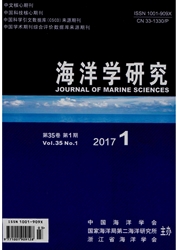

 中文摘要:
中文摘要:
基于2010年5月和2013年6月采集的黄、渤海海域的大型底栖动物数据,对该海域大型底栖动物的种类组成和群落结构等进行了研究,对该海域大型底栖动物群落结构的时间和空间差异进行了分析,并利用AMBI和m-AMBI生物指数对各站位的生态质量状况进行了评估。研究结果表明:在2010年5月和2013年6月所采站位的大型底栖动物共有131种,其中软体动物和甲壳动物占据了较大比例的物种数量,分别为51种和42种;其次为鱼类、多毛类和棘皮动物。该海域的优势物种为日本鼓虾Alpheus japonicus、日本褐虾Crangon hakodatei、司氏盖蛇尾Stegophiura sladeni和奇异指纹蛤Acila mirabilis,其中司氏盖蛇尾具有最大的丰度和优势度。生物指数(AMBI和m-AMBI)的结果显示黄、渤海区域底栖生态环境仍相对稳定,但与历史资料比较得知,该海域大型底栖动物生存环境整体趋于恶化。
 英文摘要:
英文摘要:
To elucidate the composition and structure of macrobenthic communities and their inter-annual variations in the Yellow Sea and the Bohai Sea,Agassiz trawling was conducted in May 2010 and June 2013.The composition and structure of macrobenthic communities in the Yellow Sea and the Bohai Sea were revealed and analyzed,including species composition,dominant species,abundance,biomass and community structure,and AMBI and m-AMBI were also used to assess the ecological status.The results showed as follows:A total of 131 macrobenthic species were identified,with Mollusca(51species)and Crustacea(42species)as the dominant groups in these waters,followed by fishes,polychaetes and echinoderms.There were four species whose dominance were over 0.02,including Alpheus japonicus,Crangon hakodatei,Stegophiura sladeni and Acila mirabilis,of which Stegophiura sladeni had the highest abundance and dominance.The results of benthic biological indices(AMBI and m-AMBI)showed that the benthic ecological status in the Yellow Sea and Bohai Sea was relatively stable,however,the benthic ecological quality had degraded during the last few decades when compared with historical data and published researches.
 同期刊论文项目
同期刊论文项目
 同项目期刊论文
同项目期刊论文
 期刊信息
期刊信息
